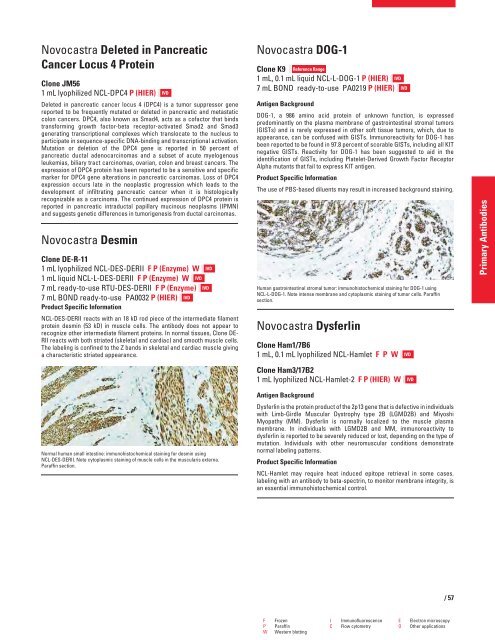QF0159 Marketing Release Record
QF0159 Marketing Release Record
QF0159 Marketing Release Record
You also want an ePaper? Increase the reach of your titles
YUMPU automatically turns print PDFs into web optimized ePapers that Google loves.
Novocastra Deleted in Pancreatic<br />
Cancer Locus 4 Protein<br />
Clone JM56<br />
1 mL lyophilized NCL-DPC4 P (HIER)<br />
Deleted in pancreatic cancer locus 4 (DPC4) is a tumor suppressor gene<br />
reported to be frequently mutated or deleted in pancreatic and metastatic<br />
colon cancers. DPC4, also known as Smad4, acts as a cofactor that binds<br />
transforming growth factor-beta receptor-activated Smad2 and Smad3<br />
generating transcriptional complexes which translocate to the nucleus to<br />
participate in sequence-specific DNA-binding and transcriptional activation.<br />
Mutation or deletion of the DPC4 gene is reported in 50 percent of<br />
pancreatic ductal adenocarcinomas and a subset of acute myelogenous<br />
leukemias, biliary tract carcinomas, ovarian, colon and breast cancers. The<br />
expression of DPC4 protein has been reported to be a sensitive and specific<br />
marker for DPC4 gene alterations in pancreatic carcinomas. Loss of DPC4<br />
expression occurs late in the neoplastic progression which leads to the<br />
development of infiltrating pancreatic cancer when it is histologically<br />
recognizable as a carcinoma. The continued expression of DPC4 protein is<br />
reported in pancreatic intraductal papillary mucinous neoplasms (IPMN)<br />
and suggests genetic differences in tumorigenesis from ductal carcinomas.<br />
Novocastra Desmin<br />
Clone DE-R-11<br />
1 mL lyophilized NCL-DES-DERII F P (Enzyme) W<br />
1 mL liquid NCL-L-DES-DERII F P (Enzyme) W<br />
7 mL ready-to-use RTU-DES-DERII F P (Enzyme)<br />
7 mL BOND ready-to-use PA0032 P (HIER)<br />
Product Specific Information<br />
NCL-DES-DERII reacts with an 18 kD rod piece of the intermediate filament<br />
protein desmin (53 kD) in muscle cells. The antibody does not appear to<br />
recognize other intermediate filament proteins. In normal tissues, Clone DE-<br />
RII reacts with both striated (skeletal and cardiac) and smooth muscle cells.<br />
The labeling is confined to the Z bands in skeletal and cardiac muscle giving<br />
a characteristic striated appearance.<br />
Normal human small intestine: immunohistochemical staining for desmin using<br />
NCL-DES-DERII. Note cytoplasmic staining of muscle cells in the muscularis externa.<br />
Paraffin section.<br />
IVD<br />
IVD<br />
IVD<br />
IVD<br />
IVD<br />
Novocastra DOG-1<br />
Clone K9 Reference Range<br />
1 mL, 0.1 mL liquid NCL-L-DOG-1 P (HIER)<br />
7 mL BOND ready-to-use PA0219 P (HIER)<br />
Antigen Background<br />
DOG-1, a 986 amino acid protein of unknown function, is expressed<br />
predominantly on the plasma membrane of gastrointestinal stromal tumors<br />
(GISTs) and is rarely expressed in other soft tissue tumors, which, due to<br />
appearance, can be confused with GISTs. Immunoreactivity for DOG-1 has<br />
been reported to be found in 97.8 percent of scorable GISTs, including all KIT<br />
negative GISTs. Reactivity for DOG-1 has been suggested to aid in the<br />
identification of GISTs, including Platelet-Derived Growth Factor Receptor<br />
Alpha mutants that fail to express KIT antigen.<br />
Product Specific Information<br />
The use of PBS-based diluents may result in increased background staining.<br />
Human gastrointestinal stromal tumor: immunohistochemical staining for DOG-1 using<br />
NCL-L-DOG-1. Note intense membrane and cytoplasmic staining of tumor cells. Paraffin<br />
section.<br />
Novocastra Dysferlin<br />
Clone Ham1/7B6<br />
1 mL, 0.1 mL lyophilized NCL-Hamlet FPW<br />
Clone Ham3/17B2<br />
1 mL lyophilized NCL-Hamlet-2 F P (HIER) W<br />
Antigen Background<br />
Dysferlin is the protein product of the 2p13 gene that is defective in individuals<br />
with Limb-Girdle Muscular Dystrophy type 2B (LGMD2B) and Miyoshi<br />
Myopathy (MM). Dysferlin is normally localized to the muscle plasma<br />
membrane. In individuals with LGMD2B and MM, immunoreactivity to<br />
dysferlin is reported to be severely reduced or lost, depending on the type of<br />
mutation. Individuals with other neuromuscular conditions demonstrate<br />
normal labeling patterns.<br />
Product Specific Information<br />
NCL-Hamlet may require heat induced epitope retrieval in some cases.<br />
labeling with an antibody to beta-spectrin, to monitor membrane integrity, is<br />
an essential immunohistochemical control.<br />
F Frozen I Immunofluorescence E Electron microscopy<br />
P Paraffin C Flow cytometry O Other applications<br />
W Western blotting<br />
IVD<br />
IVD<br />
IVD<br />
IVD<br />
/57<br />
Primary Antibodies
















